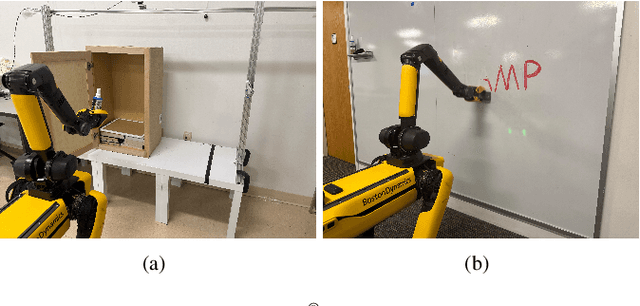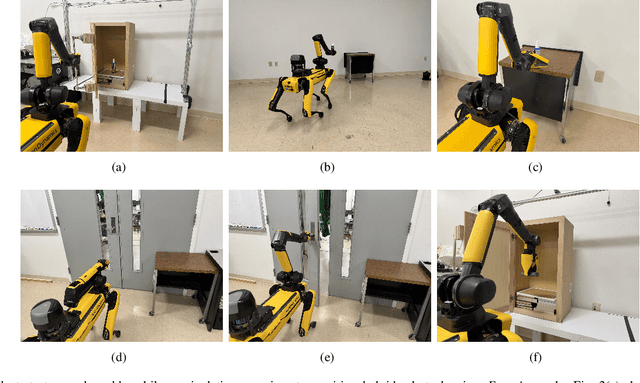Ziyi Yang
QwenLong-L1.5: Post-Training Recipe for Long-Context Reasoning and Memory Management
Dec 15, 2025Abstract:We introduce QwenLong-L1.5, a model that achieves superior long-context reasoning capabilities through systematic post-training innovations. The key technical breakthroughs of QwenLong-L1.5 are as follows: (1) Long-Context Data Synthesis Pipeline: We develop a systematic synthesis framework that generates challenging reasoning tasks requiring multi-hop grounding over globally distributed evidence. By deconstructing documents into atomic facts and their underlying relationships, and then programmatically composing verifiable reasoning questions, our approach creates high-quality training data at scale, moving substantially beyond simple retrieval tasks to enable genuine long-range reasoning capabilities. (2) Stabilized Reinforcement Learning for Long-Context Training: To overcome the critical instability in long-context RL, we introduce task-balanced sampling with task-specific advantage estimation to mitigate reward bias, and propose Adaptive Entropy-Controlled Policy Optimization (AEPO) that dynamically regulates exploration-exploitation trade-offs. (3) Memory-Augmented Architecture for Ultra-Long Contexts: Recognizing that even extended context windows cannot accommodate arbitrarily long sequences, we develop a memory management framework with multi-stage fusion RL training that seamlessly integrates single-pass reasoning with iterative memory-based processing for tasks exceeding 4M tokens. Based on Qwen3-30B-A3B-Thinking, QwenLong-L1.5 achieves performance comparable to GPT-5 and Gemini-2.5-Pro on long-context reasoning benchmarks, surpassing its baseline by 9.90 points on average. On ultra-long tasks (1M~4M tokens), QwenLong-L1.5's memory-agent framework yields a 9.48-point gain over the agent baseline. Additionally, the acquired long-context reasoning ability translates to enhanced performance in general domains like scientific reasoning, memory tool using, and extended dialogue.
DOA Estimation with Lightweight Network on LLM-Aided Simulated Acoustic Scenes
Nov 11, 2025Abstract:Direction-of-Arrival (DOA) estimation is critical in spatial audio and acoustic signal processing, with wide-ranging applications in real-world. Most existing DOA models are trained on synthetic data by convolving clean speech with room impulse responses (RIRs), which limits their generalizability due to constrained acoustic diversity. In this paper, we revisit DOA estimation using a recently introduced dataset constructed with the assistance of large language models (LLMs), which provides more realistic and diverse spatial audio scenes. We benchmark several representative neural-based DOA methods on this dataset and propose LightDOA, a lightweight DOA estimation model based on depthwise separable convolutions, specifically designed for mutil-channel input in varying environments. Experimental results show that LightDOA achieves satisfactory accuracy and robustness across various acoustic scenes while maintaining low computational complexity. This study not only highlights the potential of spatial audio synthesized with the assistance of LLMs in advancing robust and efficient DOA estimation research, but also highlights LightDOA as efficient solution for resource-constrained applications.
UniGeo: Taming Video Diffusion for Unified Consistent Geometry Estimation
May 30, 2025Abstract:Recently, methods leveraging diffusion model priors to assist monocular geometric estimation (e.g., depth and normal) have gained significant attention due to their strong generalization ability. However, most existing works focus on estimating geometric properties within the camera coordinate system of individual video frames, neglecting the inherent ability of diffusion models to determine inter-frame correspondence. In this work, we demonstrate that, through appropriate design and fine-tuning, the intrinsic consistency of video generation models can be effectively harnessed for consistent geometric estimation. Specifically, we 1) select geometric attributes in the global coordinate system that share the same correspondence with video frames as the prediction targets, 2) introduce a novel and efficient conditioning method by reusing positional encodings, and 3) enhance performance through joint training on multiple geometric attributes that share the same correspondence. Our results achieve superior performance in predicting global geometric attributes in videos and can be directly applied to reconstruction tasks. Even when trained solely on static video data, our approach exhibits the potential to generalize to dynamic video scenes.
QwenLong-L1: Towards Long-Context Large Reasoning Models with Reinforcement Learning
May 23, 2025Abstract:Recent large reasoning models (LRMs) have demonstrated strong reasoning capabilities through reinforcement learning (RL). These improvements have primarily been observed within the short-context reasoning tasks. In contrast, extending LRMs to effectively process and reason on long-context inputs via RL remains a critical unsolved challenge. To bridge this gap, we first formalize the paradigm of long-context reasoning RL, and identify key challenges in suboptimal training efficiency and unstable optimization process. To address these issues, we propose QwenLong-L1, a framework that adapts short-context LRMs to long-context scenarios via progressive context scaling. Specifically, we utilize a warm-up supervised fine-tuning (SFT) stage to establish a robust initial policy, followed by a curriculum-guided phased RL technique to stabilize the policy evolution, and enhanced with a difficulty-aware retrospective sampling strategy to incentivize the policy exploration. Experiments on seven long-context document question-answering benchmarks demonstrate that QwenLong-L1-32B outperforms flagship LRMs like OpenAI-o3-mini and Qwen3-235B-A22B, achieving performance on par with Claude-3.7-Sonnet-Thinking, demonstrating leading performance among state-of-the-art LRMs. This work advances the development of practical long-context LRMs capable of robust reasoning across information-intensive environments.
ThinkSwitcher: When to Think Hard, When to Think Fast
May 20, 2025



Abstract:Large reasoning models (LRMs) excel at solving complex tasks by leveraging long chain-of-thought (CoT) reasoning. However, this often leads to overthinking on simple tasks, resulting in unnecessary computational overhead. We observe that LRMs inherently possess the capability for efficient short CoT reasoning, which can be reliably elicited through prompt design. To leverage this capability, we propose ThinkSwitcher, a framework that enables a single LRM to dynamically switch between short and long CoT modes based on task complexity. ThinkSwitcher introduces a lightweight switching module trained with supervision signals derived from the relative performance of each reasoning mode across tasks. Experiments on multiple reasoning benchmarks show that ThinkSwitcher reduces computational cost by 20-30% while maintaining high accuracy on complex tasks. This demonstrates the effectiveness of ThinkSwitcher as a scalable and efficient solution for unified LRM deployment.
Beyond Task and Motion Planning: Hierarchical Robot Planning with General-Purpose Policies
Apr 24, 2025

Abstract:Task and motion planning is a well-established approach for solving long-horizon robot planning problems. However, traditional methods assume that each task-level robot action, or skill, can be reduced to kinematic motion planning. In this work, we address the challenge of planning with both kinematic skills and closed-loop motor controllers that go beyond kinematic considerations. We propose a novel method that integrates these controllers into motion planning using Composable Interaction Primitives (CIPs), enabling the use of diverse, non-composable pre-learned skills in hierarchical robot planning. Toward validating our Task and Skill Planning (TASP) approach, we describe ongoing robot experiments in real-world scenarios designed to demonstrate how CIPs can allow a mobile manipulator robot to effectively combine motion planning with general-purpose skills to accomplish complex tasks.
FuseRL: Dense Preference Optimization for Heterogeneous Model Fusion
Apr 09, 2025Abstract:Heterogeneous model fusion enhances the performance of LLMs by integrating the knowledge and capabilities of multiple structurally diverse models. However, existing approaches often rely solely on selecting the best output for each prompt from source models, which underutilizes their full potential due to limited source knowledge and results in sparse optimization signals. To address this limitation, we propose FuseRL, a novel two-stage framework comprising FuseSFT and FusePO to maximize the utilization of source LLMs. FuseSFT establishes a robust initialization by integrating the strengths of heterogeneous source models through weighted supervised fine-tuning (SFT) on diverse outputs for each prompt. FusePO optimizes weighted preferences based on the outputs of multiple source models to enable superior alignment performance. Extensive experiments demonstrate the effectiveness of our framework across various preference alignment methods, including RLOO, DPO, and SimPO. Using Llama-3.1-8B-Instruct as the target model, our approach achieves state-of-the-art performance among 8B LLMs on the AlpacaEval-2 and Arena-Hard benchmarks. Further analysis suggests that FuseSFT regularizes the training process to reduce overfitting, while FusePO introduces dense and diverse signals for preference optimization.
Scaling Laws of Synthetic Data for Language Models
Mar 26, 2025



Abstract:Large language models (LLMs) achieve strong performance across diverse tasks, largely driven by high-quality web data used in pre-training. However, recent studies indicate this data source is rapidly depleting. Synthetic data emerges as a promising alternative, but it remains unclear whether synthetic datasets exhibit predictable scalability comparable to raw pre-training data. In this work, we systematically investigate the scaling laws of synthetic data by introducing SynthLLM, a scalable framework that transforms pre-training corpora into diverse, high-quality synthetic datasets. Our approach achieves this by automatically extracting and recombining high-level concepts across multiple documents using a graph algorithm. Key findings from our extensive mathematical experiments on SynthLLM include: (1) SynthLLM generates synthetic data that reliably adheres to the rectified scaling law across various model sizes; (2) Performance improvements plateau near 300B tokens; and (3) Larger models approach optimal performance with fewer training tokens. For instance, an 8B model peaks at 1T tokens, while a 3B model requires 4T. Moreover, comparisons with existing synthetic data generation and augmentation methods demonstrate that SynthLLM achieves superior performance and scalability. Our findings highlight synthetic data as a scalable and reliable alternative to organic pre-training corpora, offering a viable path toward continued improvement in model performance.
FuseChat-3.0: Preference Optimization Meets Heterogeneous Model Fusion
Mar 06, 2025Abstract:We introduce FuseChat-3.0, a suite of large language models (LLMs) developed by integrating the strengths of heterogeneous source LLMs into more compact target LLMs. Our source models include the powerful Gemma-2-27B-it, Mistral-Large-Instruct-2407, Qwen-2.5-72B-Instruct, and Llama-3.1-70B-Instruct. For target models, we focus on three widely-used smaller variants-Llama-3.1-8B-Instruct, Gemma-2-9B-it, and Qwen-2.5-7B-Instruct-along with two ultra-compact options, Llama-3.2-3B-Instruct and Llama-3.2-1B-Instruct. To leverage the diverse capabilities of these source models, we develop a specialized data construction protocol tailored to various tasks and domains. The FuseChat-3.0 training pipeline consists of two key stages: (1) supervised fine-tuning (SFT) to align the target and source model distributions, and (2) Direct Preference Optimization (DPO) to apply preferences from multiple source LLMs to fine-tune the target model. The resulting FuseChat-3.0 models exhibit significant performance gains across tasks such as instruction following, general knowledge, mathematics, and coding. As illustrated in Figure 1, using Llama-3.1-8B-Instruct as the target model, our fusion approach achieves an average improvement of 6.8 points across 14 benchmarks. Moreover, it demonstrates remarkable gains of 37.1 points and 30.1 points on the instruction-following benchmarks AlpacaEval-2 and Arena-Hard, respectively. Our code, models, and datasets are available at https://github.com/SLIT-AI/FuseChat-3.0.
Phi-4-Mini Technical Report: Compact yet Powerful Multimodal Language Models via Mixture-of-LoRAs
Mar 03, 2025



Abstract:We introduce Phi-4-Mini and Phi-4-Multimodal, compact yet highly capable language and multimodal models. Phi-4-Mini is a 3.8-billion-parameter language model trained on high-quality web and synthetic data, significantly outperforming recent open-source models of similar size and matching the performance of models twice its size on math and coding tasks requiring complex reasoning. This achievement is driven by a carefully curated synthetic data recipe emphasizing high-quality math and coding datasets. Compared to its predecessor, Phi-3.5-Mini, Phi-4-Mini features an expanded vocabulary size of 200K tokens to better support multilingual applications, as well as group query attention for more efficient long-sequence generation. Phi-4-Multimodal is a multimodal model that integrates text, vision, and speech/audio input modalities into a single model. Its novel modality extension approach leverages LoRA adapters and modality-specific routers to allow multiple inference modes combining various modalities without interference. For example, it now ranks first in the OpenASR leaderboard to date, although the LoRA component of the speech/audio modality has just 460 million parameters. Phi-4-Multimodal supports scenarios involving (vision + language), (vision + speech), and (speech/audio) inputs, outperforming larger vision-language and speech-language models on a wide range of tasks. Additionally, we experiment to further train Phi-4-Mini to enhance its reasoning capabilities. Despite its compact 3.8-billion-parameter size, this experimental version achieves reasoning performance on par with or surpassing significantly larger models, including DeepSeek-R1-Distill-Qwen-7B and DeepSeek-R1-Distill-Llama-8B.
 Add to Chrome
Add to Chrome Add to Firefox
Add to Firefox Add to Edge
Add to Edge